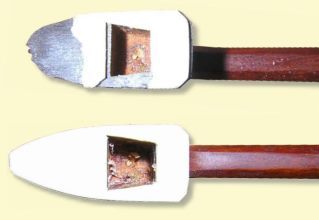|
Repair and Restoration Seminar
Decapitated Bow
The bow is made of long and thin stick and extremely exquisite materials, Consist of pernambuco, Ebony, Ivory, Tortoiseshell, silver ring and wire, shell, etc., all vulnerable to acidic sweat corrosion, fingernail wear, humidity, slanting crack, or breakage and damage due to improper use. This is particular true when it comes to a famous ancient bow with even more injuries in need of a highly professional and well-experienced master bow repairer to work on it meticulously, otherwise, a once faulty repair will bring about a state beyond redemption and immeasurable loss.
1. Decapitated Bow

Fig 1.Pre-restoration.

Fig 2.Post-restoration.

Fig 3.Top view.
2. Ivory Tip Cracks by Striking

Fig 4.Pre-and post-restoration.

Fig 5.Pre-and post-restoration.

Fig 6.Pre-and post-restoration.
3. Head Mortise Bushing
Exceedingly wide and large head mortise (horsehair mortise) that thins the edge is extremely risky and vulnerable to crack. The mortise size must be reduced. A smaller mortise may be dug out again only after completed bushing with pernambuco or ebony is made.

Fig 7.Oversized head mortise before restoration.

Fig 8.Reduced head mortise after restoration.
4. Bow Retouch
Damaged cheek of bow tip by pressing with obvious scratches on both sides. When retouch after restoration is perfected, the ivory tip is also replaced.

Fig 9.Violin bow by Francois Peccatte (left side).

Fig10.Violin bow by Francois Peccatte (right side).
|